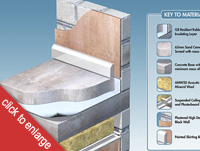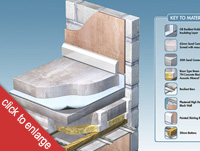INSTALLATION GUIDE FOR ACOUSTICEL G8
Download this as a PDF file here
NOTE. THESE INSTRUCTIONS MUST BE FOLLOWED OTHERWISE INCORRECT INSTALLATION COULD OCCUR WHICH MAY HAVE A DETRIMENTAL EFFECT ON THE PERFORMANCE!
Applications
Suitable for new build of most concrete separating floors installed into buildings of two storeys or more. Please note, as the structures of floors and their supporting walls varies significantly with each individual building, it may be necessary to install additional insulating measures in some cases. In the case of a newly sound insulated separating floor failing a test, contact our technical department for advice.
8mm thick G8 is a resilient recycled rubber insulation providing effective sound loss when installed beneath a concrete screed. Its unique formulation compensates for minor irregularities in existing floor constructions and complies with the Building Regulations for newly built concrete suspended floors.
Preparation for Conversions
The concrete base must be of the correct density of not less than 300kg/m2 and be reasonable level with no holes or gaps. In the case of beam and block flooring, these should be sealed with a sand/cement levelling screed thick enough to bring the base floor up to the required density.
Dividing Walls or Partitions
Load bearing and dividing walls and partitions should be constructed from the base floor before installation of floating floors and ceilings. Under no circumstances should G8 be used as a load bearing component. 10mm thick Acousticel M10AD can be used as a resilient insulation to isolate studwork if required which can be easily cut with a jigsaw.
Installation of Floating Floor
Before installing a floating screed, the G8 sound insulation must be laid with the BACKING FABRIC UPPERMOST with the joints overlapped by 50mm and lapped up the walls high enough to contain the screed. Usually about 20cm. Duct tape can be used to facilitate this.
If a re-enforcing mesh is to be used, it should be laid on top of the G8 prior to installing the screed that must have a minimum thickness of 65mm. The insulation can be trimmed down to floor level once the screed has cured. Dot and dab wallboards should only be installed after the floating floor has been laid and as with the skirting boards, the wallboards should not come into contact with the floor.
A gap of approx. 5mm between the bottom of the dry lining and the floor surface should be allowed. When applying the skirting boards, allow a 2-3mm gap between the skirting and the top of the flooring. It is important this gap is maintained and not filled with any type of sealant!!
Ceilings
If a separate ceiling is to be installed which will create a void beneath the concrete floor, then the void should be filled with Acoustic Mineral Wool to reduce the possibility of reverberation problems. Try to avoid fitting downlighters into the ceiling as these may affect the performance of the sound insulation! If downlighters are required, these should have our acoustic hoods designed specifically for downlighters installed above them.
For more information on installing our products, please contact our technical department.




